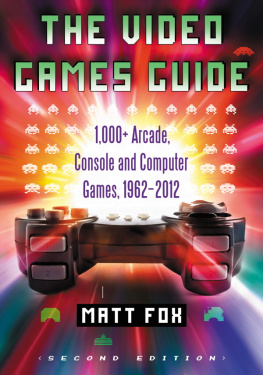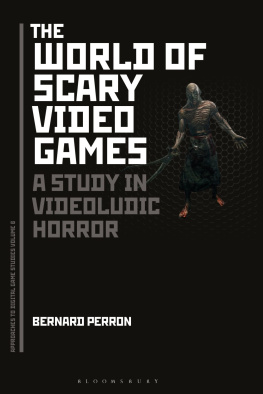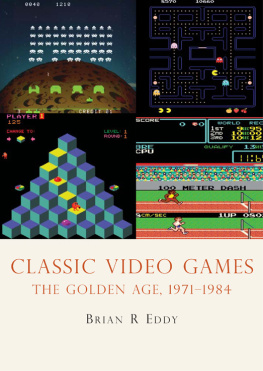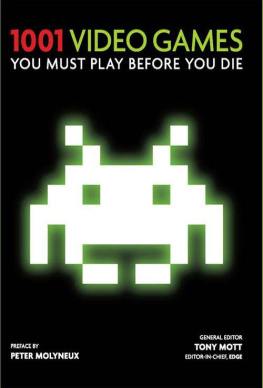THE
VIDEO GAME
GUIDE
VOLUME 1
1947-1989
Peter Cruickshank
First published in the UK in 2021 by Peter Cruickshank
ISBN 978-0-9927964-9-5
Copyright Peter Cruickshank, 2021
British Library Cataloguing in Publication Data.
A catalogue record for this book is available from the British Library.
All rights reserved. No part of this book may be reproduced by any means, nor transmitted, nor translated without the written permission of the author.
The right of Pete Cruickshank to be identified as the author of this work has been asserted in accordance with sections 77 and 78 of the Copyright, Designs and Patents Act 1988.
Publishers Note
Although the information in this book is believed to be accurate and true at the time of going to be press, neither the author nor publisher can accept any legal responsibility or liability for any errors or omissions that may have been made.
facebook.com/thevideogameguide
DEDICATION
To everyone who has ever found thrills, suspense, glory, wonder, escapism, love, loss and life in a video game.
Contents
DEDICATION
ACKNOWLEDGMENTS
INTRODUCTION
The 1940s
The 1950s
The 1960s
The 1970s
1980
1981
1982
1983
1984
1985
1986
1987
1988
1989
Notes
Glossary
Sources Used
ACKNOWLEDGMENTS
First of all, I would like to thank Iain Stirling who unwittingly helped sow the seeds for this book with our passionate talks about computer games of the 1980s during a holiday to Disney World with our families in 2019. Steff El Madawi for giving initial editing pointers and advice. My chief editor Steph Dagg for all her hard work. Paul Johnson, Ed Pulis and Alice Tennant for proofreading the book. To everyone who has advised and listened to me hark on about what would, one day, become the Video Game Guide. Finally for the support of my loving wife, Catherine.
INTRODUCTION
My first experiences with video games go back to the late 1970s playing arcades such as Space Invaders (1978), Asteroids (1979), and Galaxian (1979). My familys very first video game console here in the United Kingdom was a Binatone TV Master System (1976). Although this book is encyclopedic in nature, I would like to state that video games are as much about the passion and the emotions they evoke within us more than anything else. For it is our personal experiences that make them important to us and have a lasting effect on us for many years to come.
All these experiences are as real as anything that happens in our everyday lives. For every game mentioned in this book, there is someone out there on whom it has had a significant impact. From the most primitive, purely text-based adventure and roguelike games, where the players imagination did the grunt work, to the vast immersive open-world games of today. All of these experiences should be cherished.
When we consider how far video games have come over the last seventy years we can only imagine where the future will take us and how they will evolve. We can predict that video games will look even more real and become even more immersive and that all of this is only the beginning.
I wanted to write a book about video games that focuses as much on their origins as it does on their more contemporary embodiments (covered in later volumes), that acknowledges games not only from Japan and the USA but from other parts of the world too. Giving the reader exposure to not only triple-AAA titled blockbuster games but also to indie and casual games. This book also covers many of the hardware innovations over the years and I hope this will give the reader an idea of the complete history of video games while also acting as reference material and guide.
Peter Cruickshank
Note: A Glossary of terms can be found at the back of this book.
Video Game
Noun
A game played by electronically manipulating images produced by a computer program on a monitor or other display.
(Oxford Dictionary)
The 1940s
1940s Introduction
It wasn't until the middle of the twentieth century when what would later be considered the first video games were invented. The technicians who utilised this new emerging technology, known as computers, needed a way to illustrate the capabilities of these enormous and complex machines to the average layperson. What better way than an entertaining, fun game.
It is worth noting that many of these games or simulations of this era were developed in universities, research labs, large corporations, or sections of government. Said examples were often never demonstrated to the media or the public at the time. Many never saw the light of day, or werent documented in any reliable way, and are now lost to history.
The following examples are a glimpse of what we do know. Yet like so much of the past, they are only a small part of the story.
The cathode-ray tube amusement device and Gun Data Computers
Date: 1947
Region: USA
Inventors: Thomas T. Goldsmith and Estle Ray Mann.
Connecting a cathode-ray tube (CRT) to an oscilloscope, the user controls an artillery shell arcing towards specific targets using knobs and switches. Though the concept is like that of what would later become known as a video game, many people do not consider this device as such since the cathode-ray amusement device has no computing component. There is also contention as to whether it was ever built.
However, it is well-known that during the 1940s the military used similar technology to develop a series of what is known as the gun data computers to calculate ballistic trajectories.
Turochamp
Date: 1948
Region: UK
Inventors: Alan Turing and David Champernowe
Platform: Automatic Computing Engine, and later for the Ferranti Mark 1.
Turochamp was a chess program. Written to calculate all possible moves at any point in the game and assign the best possible move for that state. Unfortunately, the program was too complex to be run on any computer of the time.
The 1950s
1950s Introduction
Even though it would be another twenty years before the term video game would emerge, it was during the 1950s that what is defined as the first true video game was developed. However, as we will see, there is considerable contention as to whether this accolade goes to Draughts (1952), OXO (1952), Pool/Billiards (1954), or Tennis for Two (1958).
This decade also saw far-reaching fundamental hardware innovations, such as the first hard disk drive (1956) and the successful invention of the first integrated circuit (1958).
Bertie the Brain
Date: 1950
Region: Canada
Inventor: Dr Josef Kates
The Bertie the Brain computer was used to play tic-tac-toe, also known as noughts and crosses. The computer was four metres tall and used an array of light bulbs instead of a screen. There is contention as to whether this qualifies as a video game, as there were no moving graphics, only a primitive array of bulbs to display the shapes.
Nimrod
Date: 1951
Region: UK
Inventors: Raymond Stuart Williams and designed by John Makepeace Bennet
Platform: Nimrod
Tic-tac-toe and the game Nim were played on the vacuum tube computer, Nimrod at the Festival of Britain in May 1951. Built by Raymond Stuart Williams and designed by John Makepeace Bennet, Nimrod also uses bulbs rather than a monitor or other similar display and so may not qualify as a true video game, more a precursor.
UNISERVO Tape Drive
The UNISERVO tape drive was developed in 1951 for the UNIVAC 1 computer. It was the first available commercial tape drive. The storage capacity for a tape was 224 Kilobytes (224 KB or simply referred to as 224 K). This new way of storing data would later help those wishing to distribute software and, in turn, games.
Next page





![Mark J. P. Wolf (editor) - Encyclopedia of Video Games: The Culture, Technology, and Art of Gaming [3 volumes]](/uploads/posts/book/279290/thumbs/mark-j-p-wolf-editor-encyclopedia-of-video.jpg)


